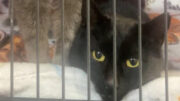Last summer, I had the pleasure of watching a fat bumblebee joyfully buried deep in the center of an orange tithonia blossom, covering itself with pollen. The insect was oblivious to me as I moved in closer and closer to photograph the spectacle while standing in the garden barefoot on soft green grass.
I’ve been growing the “Torch” variety for more than 20 years and sing its praises to anyone who will listen. The plant was awarded the coveted All-America Selection title in 1951 and has been pleasing gardeners ever since. When my kids were little, we would sit out in the garden as the late afternoon sun backlit the gorgeous, three-inch blooms, waiting for ruby-throated hummingbirds to arrive. The highly territorial birds performed aerial combat, and we would watch as they dived and parried, listening to the high-pitched shrill calls as they fought for the right to feed.
Those are just two of the visitors to the plant, which acts as a pollinator magnet. Gardeners can help themselves and the environment by planting for beneficial wildlife like bees, butterflies, moths and any other creature that will move pollen from one flower to another.
It’s imperative though to forget about using chemicals in the garden, as they have a devastating effect on the good guys. As an organic gardener for more than 30 years, trust me when I tell you the conversion to safe and natural gardening is not nearly as traumatic as you might think. Feeding the soil with compost, knowing when plants go in the ground and keeping them from drying out will provide you with the proverbial green thumb.
The ‘Torch’ tithonia (Mexican sunflower) can be started indoors four weeks before the last frost, which in our area usually occurs during the third week of May. It can also be direct sowed in the garden. Since it’s a late bloomer (like me), earlier flowers come from seeds sown inside. The resulting plant will reach six to 16 feet tall, depending on soil quality and sun. The thick stalks will be covered in three-inch orange flowers that persist past frost and finally give up during the first hard freeze. Best of all, the plant doesn’t need much from the gardener and will even bloom with as little as five hours of sun.
Here are some of my other easy-to-grow pollinator plants recommendations:
• Milkweed is the lone host plant for monarch butterflies, which are in decline. There is some data showing the monarchs are starting to come back as gardeners have collectively been adding the plant to their gardens. Common milkweed, showy milkweed, swamp milkweed, butterfly weed and tropical milkweed are all options to help the butterfly, and they will also attract other pollinators. The tropical milkweed is considered an invasive in warmer climates and shouldn’t be planted unless it’s in an area that has a good frost.

Mary Canny, of Baldwin, has found three plants the deer don’t like, zinnias, cannas and elephant ears. A bumblebee flies from one zinnia to another in her garden.
• Nothing could be easier to grow than zinnias. There are a multitude of shapes and sizes. The “Cut and Come Again” mixture is a favorite. Zinnias always seem to do better when direct sowed in the garden around mid-May as opposed to starting early or buying them in flats. The plant is prone to powdery mildew but often outpaces the problem when planted directly in the garden.

A honey bee visits tithonia (Mexican sunflower). It’s Doug Oster’s favorite plant for attracting pollinators.
• Cosmos are planted the same way and I couldn’t imagine a garden without them. “Dazzler” can reach five feet high, will dance in the breeze and be covered in butterflies. The plant is a half-hardy annual meaning it will shake off the first few frosts.
• Sunflowers are easy to grow and provide food for lots of wildlife. They are planted right in the garden in mid-May. The newly sprouted seedlings are favorites of rabbits and deer, so they can be sprayed with a natural deterrent like Bobbex. “Mammoth Greystripe” will tower in your garden, providing pollen and then seeds for the birds as the flowerhead begins to look downward.
• There are some great mixes, filled with perennial and annual seeds out there too. “Wildflower Pollinator Honey Bee Mix” and “Monarch Butterfly Garden Mix” provide plants with pollen and nectar. When helping the monarchs and other pollinators, it’s important to have a food source for them later in the season, which is included in the mix of seeds.
Those are just some of the easier-to-grow varieties to help pollinators, but the list is long. The Xerces Society has a great compilation of perennials, shrubs, trees, herbs and annuals that will attract pollinators to the garden.
By growing plants that pollinators love, you’ll get more flowers and vegetables, but best of all, you’re helping our local habitat, preserving it for our children and grandchildren to enjoy as we have.
Doug Oster is editor of Everybody Gardens, a website operated by 535Media, LLC. Reach him at (412) 965-3278 or doster@535mediallc.com. See other stories, videos, blogs, tips and more at EverybodyGardens.com.
Here is a link for Xerces Society: xerces.org/pollinator-conservation/plant-lists/
Doug has put his favorite pollinator seeds together in his Save The Planet Collection available at Everybody Gardens.


































